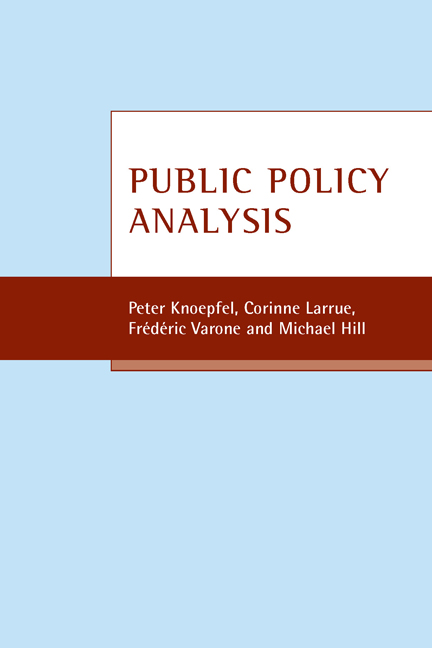seven - Political agenda setting
Published online by Cambridge University Press: 14 January 2022
Summary
If, as defined in Chapter Two, public policies consist of a group of activities and decisions taken by different actors with a view to resolving a problem that is politically defined as public in nature, it is important first and foremost to look into the actual concept of ‘public problem’.
In this chapter, we discuss the processes whereby a social problem is identified and then ‘thematicised’ as a public problem as well as the different characteristics of agenda setting. According to our analytical model, the political definition of the public problem (PD) constitutes, in effect, the first product that the analyst must study when tackling the cycle of public intervention in the context of an empirical study.
In reality, the processes involving the political definition – and redefinition – of public problems have not been the subject of theoretical and empirical analyses that are comparable, in number at least, with those carried out on the (subsequent) stages of policy programming, implementation and evaluation. Obviously, the failure to take the stakes associated with the definition of the problem tackled by a policy into account is a definite drawback when it comes to the analysis of this policy, including studies carried out on its implementation:
Yet we know that the problem definition stage frames and generates virtually everything that follows in the policy process, so our failures to examine problem definition sentences us to operate through a glass darkly (DeLeon, 1994, p 89).
As Anderson (1978, p 20) and others demonstrate, the development of a policy cannot be interpreted as the simple resolution of given problems defined on the basis of their intrinsic characteristics. It also involves the constitution and definition of public problems. This is a political designation process that influences or determines the actors involved in the policy (that is, the public authorities of the political-administrative arrangement [PAA], the target groups, the end beneficiaries and third-party groups), and the actual nature of the public actions carried out (that is, the modes of intervention selected in the political-administrative programme [PAP]).
From this perspective and by way of introduction, we stress the need for a (re-)constructive analysis of public problems (Section 7.1). Then, in accordance with the structure proposed in Chapter Six, we will move on to the general definition and operationalisation of the concept of the ‘public problem’ (Section 7.2).
- Type
- Chapter
- Information
- Public Policy Analysis , pp. 125 - 150Publisher: Bristol University PressPrint publication year: 2007



